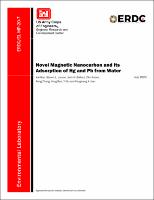Please use this identifier to cite or link to this item:
https://hdl.handle.net/11681/37373Full metadata record
| DC Field | Value | Language |
|---|---|---|
| dc.contributor.author | Larson, Steven L. | - |
| dc.contributor.author | Ballard, John H. | - |
| dc.contributor.author | Guo, Kai | - |
| dc.contributor.author | Arslan, Zikri | - |
| dc.contributor.author | Han, Fengxiang X. | - |
| dc.contributor.author | Zhang, Rong | - |
| dc.contributor.author | Ran, Yong | - |
| dc.contributor.author | Su, Yi | - |
| dc.date.accessioned | 2020-07-10T13:55:25Z | - |
| dc.date.available | 2020-07-10T13:55:25Z | - |
| dc.date.issued | 2020-07 | - |
| dc.identifier.govdoc | ERDC/EL MP-20-7 | - |
| dc.identifier.uri | https://hdl.handle.net/11681/37373 | - |
| dc.identifier.uri | http://dx.doi.org/10.21079/11681/37373 | - |
| dc.description | Miscellaneous Paper | en_US |
| dc.description.abstract | Lead and mercury are two of the most toxic heavy metals in environments. Mesosilicate-templated magnetic nanocarbons with ascorbic acid as carbon precursor were developed through nanocasting processes. The nanocarbon showed effective magnetic separation and the maximum adsorption capacity of 80.6 and 66.3 mg/g for Hg and Pb, respectively. Langmuir model well described adsorption processes of both Hg and Pb from water. Magnetic nanocarbon could be easily separated and incinerated, reducing the volume requiring the disposal. This study indicates that mesosilicate-templated nanocarbons with easy disposal potentials may be good candidates for cleansing Hg and Pb from contaminated water. | en_US |
| dc.description.sponsorship | Project Number 458170, “Depleted Uranium (DU) Clearance from DoD Ranges” | en_US |
| dc.description.sponsorship | Collaborative work was conducted by the U.S. Army ERDC and Jackson State University via Cooperative Agreement W912HZ-16-2-002. | - |
| dc.format.extent | 15 pages / 1.17 MB | - |
| dc.format.medium | PDF/A | - |
| dc.language.iso | en_US | en_US |
| dc.publisher | Environmental Laboratory (U.S.) | en_US |
| dc.publisher | Engineer Research and Development Center (U.S.) | - |
| dc.relation.ispartofseries | Miscellaneous Paper (Engineer Research and Development Center U.S.));no. ERDC/EL MP-20-7 | - |
| dc.rights | Approved for public release; distribution is unlimited | - |
| dc.source | This Digital Resources was created in Microsoft Word and Adobe Acrobat | - |
| dc.subject | Adsorption | en_US |
| dc.subject | Mesoporous | en_US |
| dc.subject | Nanocarbon | en_US |
| dc.subject | Silicate | en_US |
| dc.subject | Radionuclide | en_US |
| dc.subject | Heavy metals | en_US |
| dc.title | Novel magnetic nanocarbon and its adsorption of Hg and Pb from water | en_US |
| dc.type | Report | - |
| Appears in Collections: | Miscellaneous Paper | |
Files in This Item:
| File | Description | Size | Format | |
|---|---|---|---|---|
| ERDC-EL MP-20-7.pdf | 1.17 MB | Adobe PDF |  View/Open |